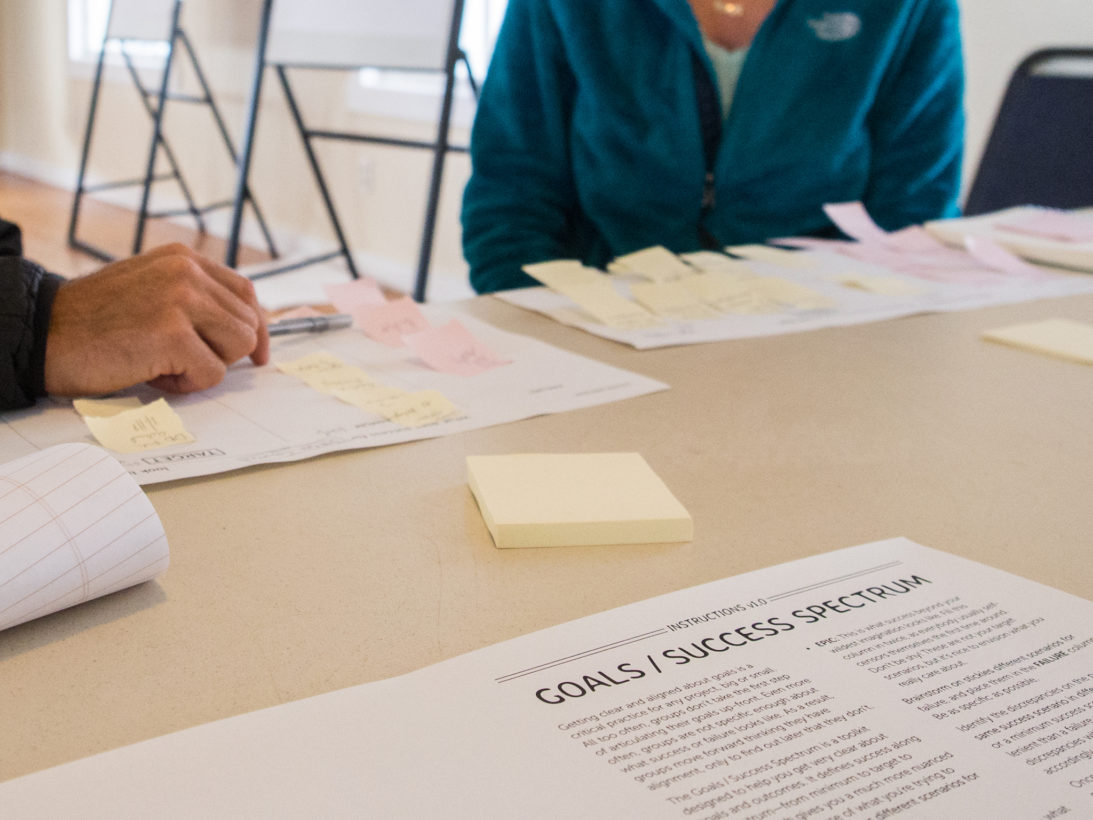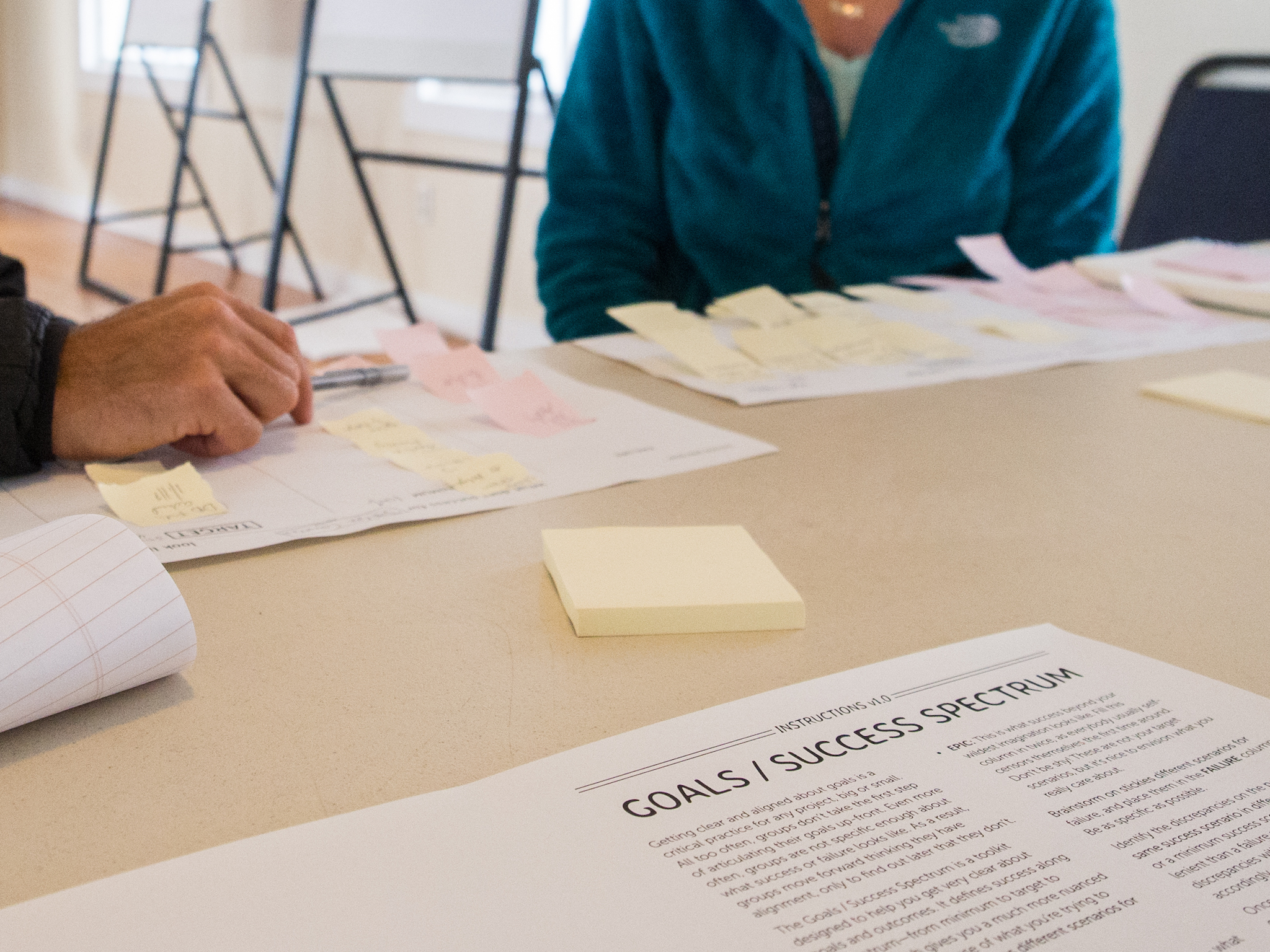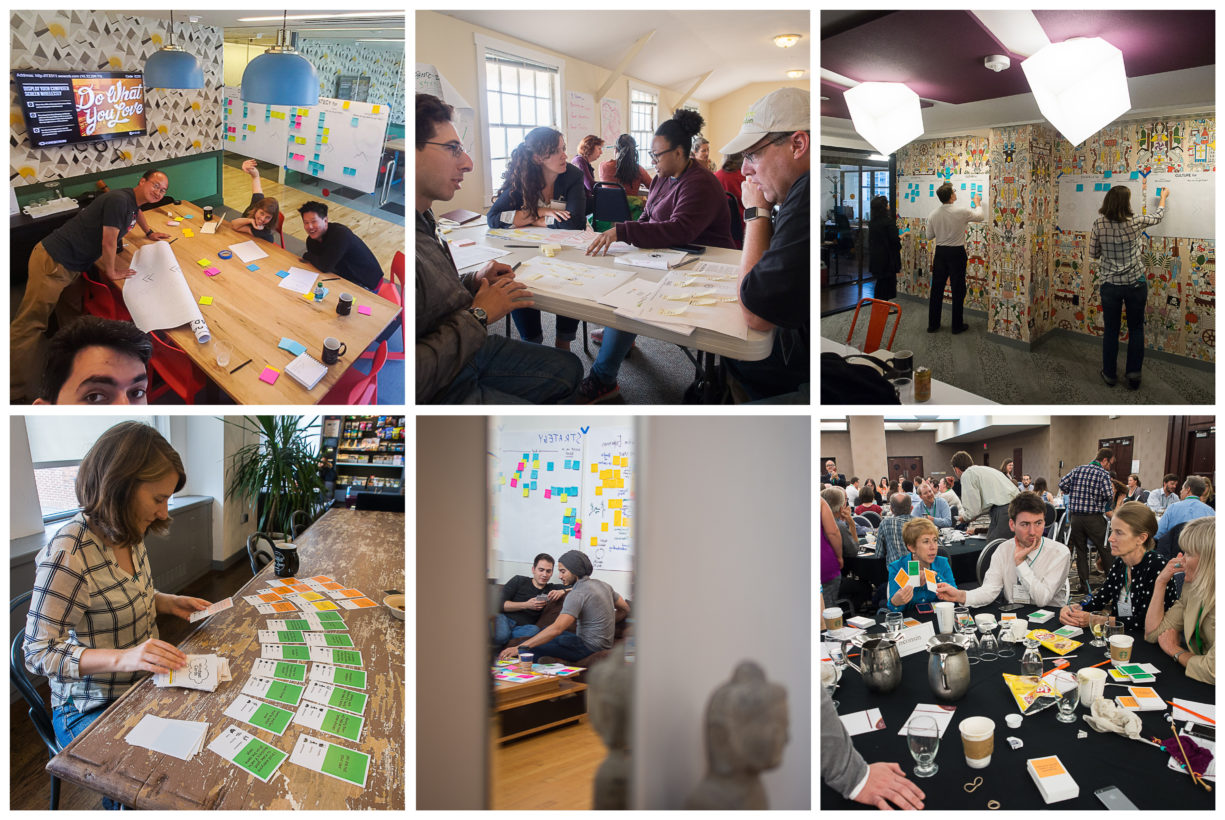

This past year, I facilitated a number of workshops on the Goals + Success Spectrum, the tool I use to help groups get clear, specific, and aligned around objectives and metrics. It’s essentially a guided brainstorming activity (using sticky notes or Google Docs) where you categorize your goals across a spectrum — from Minimum to Target to Epic.
I’ve been focusing on doing trainings for this tool rather than my others, because it’s a low-overhead, high-leverage way to get groups aligned and practicing, which are critical steps toward achieving high performance. It’s useful for individuals and for groups, and people generally recognize its utility immediately, even without the benefit of a workshop.
In my workshops, I focus on helping participants experience the mechanics of the tool. They practice using it as individuals, then spend time reviewing each other’s spectrums in pairs and giving each other feedback. I offer no other guidance about using it with groups other than to follow the exact same instructions.
In practice, of course, using the tool with groups is harder than with an individual. Multiple people mean more ideas, and you have to figure out how to consolidate them. That requires critical thinking, communication, conflict, and convergence — all things that make collaboration hard in the first place.
My stated reasons for not offering additional guidance for groups are:
- The tool itself is designed to address some of these collaboration challenges
- I want groups to learn how to work through the harder challenges by trusting their own skills, by using the tool repeatedly, and learning and adjusting as they go. That’s ultimately the point of all of my tools — to help people develop strong collaboration muscles and habits through practice.
While these are true, I also just find it hard to offer simple advice about how to facilitate this with groups. Any tactical advice I might have is deeply intertwingled with my philosophy about collaboration, groups, and the design of my tools in general. I can’t talk about one without the other.
All that said, many participants in my workshops have asked thoughtful questions about how to use the Goals + Success Spectrum with groups, so I’m going to attempt to articulate the relevant aspects of my philosophy and answer their questions here.
My Beliefs About Groups
I believe that:
- Most of the challenges that groups face stem from not talking with each other enough about the right things.
- People are generally smarter than we give them credit for. If we give people the space and opportunity to be at their best, then we can tap into a group’s collective wisdom, which is greater than the sum of its individual parts.
- Collaboration is a craft. You will be bad at it at first, but with enough practice, you will eventually get better.
At their core, all of my tools — including the Goals + Success Spectrum — are designed to do three things:
1. Remind you to think about critical, foundational questions. These questions are easy to take for granted, but in our day-to-day grind, we often forget to think about them. In the case of the Goals + Success Spectrum, the questions are:
- What would the spectrum of success look like for your project, from Minimum to Target to Epic?
- What would failure look like for your project?
2. Encourage you to write down your answers so that you and others can see them. Forcing you to make the implicit explicit and specific helps you get clear individually and is a critical step helping groups align.
3. Make it easy to practice over and over again. My tools were designed to help you practice and develop strong muscles and habits around group process. The tools themselves aren’t as important as your group continuing to develop and use the right muscles.
My basic approach to using all of my tools with groups is to just use them. Get people in a room, run through the instructions, and see what happens. Groups often are more capable than they themselves believe. This is the best way to demonstrate that.
At best, the tool will encourage everyone to stretch their thinking, de-personalize the ideas, and help people feel heard, which will lead to safer, more constructive conversations. This, along with incorporating a greater diversity of perspectives, will improve the overall quality of and lead to greater collective ownership over the final outcome.
At worst, everybody will get to see what each other thinks, and you’ll learn something from doing the exercise. Make some adjustments based on what you learn, and try it again. And again. People will learn how to set better targets and how to navigate difficult conversations with each other. It’s like learning to speak a language or play an instrument. Failure is both inevitable and okay, as long as you continue to try and learn.
Facilitation Tactics for the Goals + Success Spectrum
Given all this, here are some of the questions people in my workshop asked about how to use the Goals + Success Spectrum, along with my thoughts.
Who in your group should use the Goals + Success spectrum?
Everyone. Talking through goals and success should always be a group exercise, not an individual one. Deciding on goals and metrics doesn’t have to be a consensus activity (and you should be clear about how decisions will be made up front), but coming up with good ones benefits from everyone’s voice.
That said, with larger groups, it may not be practical to bring everyone into the room for the whole process. In these cases, you should aim to have a representative cross-section of the group participate (which means it should not just be the leadership team), with entry points for everyone else to review and give feedback.
How does having groups use the Goals + Success Spectrum work in practice?
There are two constraints: space and time. Larger (simultaneous) groups require more physical space, both to be in a room together and to capture their thinking. It doesn’t necessarily require significantly more time to capture and read everyone’s ideas, because that’s happening in parallel, but it definitely takes more time to work through hard questions and conflict and ultimately converge and align.
I generally find that groups do not allocate enough time for to thinking through goals and success (the “what” and the “why”), instead preferring to rush to the “how.” Alignment is hard, but the payoff is enormous. It doesn’t help if everyone in a boat quickly starts to row if they’re not all rowing in the same direction. Agreeing on where to go might take time, but it will make the subsequent rowing a lot easier.
Why does alignment take so long? Because people’s perspectives are often rooted in deeply held beliefs, and understanding and reconciling those beliefs can take time. Again, groups don’t have to decide on goals and success by consensus. However, alignment is much more likely if people understand the underlying reasons behind a decision and if they feel others understand the reasons for their objections.
You can accelerate alignment through the tool in two ways. First, explore different scenarios before getting into arguments. Second, continuously synthesize and edit the spectrum so that areas of alignment and misalignment are sharpened. I often joke that using these tools with groups is ultimately an exercise in sticky note management, but it’s true. The more you can help keep it clean, the more the group will be able to focus on the important challenges.
While the tools are designed to support a healthy group conversation, they are not a panacea. Any time you’re having a group discussion, group dynamics come into play. By giving everyone an opportunity to fill out and share their ideas on stickies, the tool encourages inclusion. However, once people start talking about the ideas, the tool can’t prevent the voices of a few from drowning out everyone else’s, for example. If this is a frequent problem, you may want to consider appointing a facilitator from either inside or outside of your group.
How would you use the Goals + Success Spectrum across multiple groups within a larger organization or group (e.g. cross-functionally)?
One of the reasons I love doing the Goals + Success workshop is that it’s a great way to build community, because looking at a filled-out spectrum is a great way to get to know another person or group quickly and more deeply. Knowing that your group works on housing issues tells me a little bit. Knowing that your group is trying to create housing for 10,000 people in one year tells me a lot more.
Similarly, the Goals + Success Spectrum can be a powerful way to help de-silo an organization or network. I would have each sub-group do their own spectrums first, then bring all the groups together to gut check each other’s spectrums. Celebrate where the different spectrums complement each other, discuss where they conflict and why, and make adjustments in the respective spectrums.
Most importantly, put the completed spectrums somewhere so that everyone can easily find and see each other’s.
How do you use the Goals + Success Spectrum to assess success or failure afterward?
I start every debrief by asking everyone to review each column of the Goals + Success Spectrum and to mark the ones we achieved and the ones we missed. (I use this debrief template to guide the process.) If there are differences in opinion as to whether or not we hit a mark, that’s both an opportunity to make meaning of what happened and to come up with a more specific and objective metric for next time.
If the group has missed marks in the Minimum column, then the project is technically a failure. This is an opportunity to discuss whether or not you had the right minimum targets and to make adjustments for next time.
Aligning around success is a craft. If you do it repeatedly, you will get better at it over time. Use your spectrums to help you with your assessments, but also recognize that the assessments will help you create better spectrums next time.





